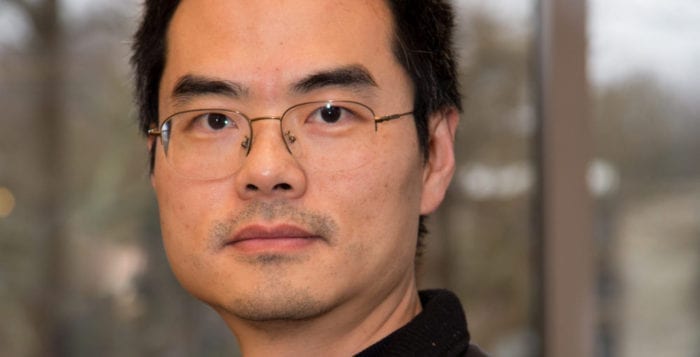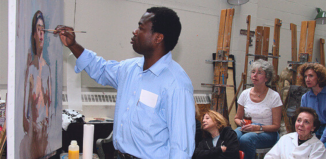SBU’s Ye scores $450K from NSF to design smart environment
By Daniel Dunaief
Fan Ye has a vision for the future filled with high service and efficiency that doesn’t involve butlers or personal attendants. The assistant professor of electrical and computer engineering in the College of Engineering and Applied Sciences at Stony Brook University is focused on creating smart environments in which window blinds open as people pull into their driveways, lights turn off in unoccupied rooms and the building guides a new student turn by turn through complex floors and hallways from entrance to the registrar’s office.
“The physical environment would be like a caring mother,” said Ye. It would sense and figure out people’s needs and “take care of the occupants inside the building.”
In Ye’s vision, which he estimates is about one year to decades away from a reality, objects that rely on people to turn them on or off, reposition them or alter their settings would have chips embedded in them, working together to create an environment that anticipates and learns in response to the need around it.
“With sensors, [a smart environment] can sense both physical conditions and human activities and adjust the environment in manners that create/improve comfort, safety, convenience” and the productivity of the occupant, he explained in an email.
Ye recently received a $450,000 award over the next five years from the National Science Foundation for early-career faculty for his study of smart environments. The prestigious award is the highest honor given by the government to scientists and engineers beginning their independent careers.
Initially, Ye is developing and testing a security system with the Stony Brook University Police Department and the Center of Excellence in Wireless and Information Technology that grants specific access to buildings or facilities depending on the specifications of an administrator.
Many of the buildings on campus have electric locks, which someone can open with a badge where there’s a badge reader. A badge, however “isn’t that flexible,” Ye said. If an administrator would like to grant someone one-time access to open a door that doesn’t provide ongoing access, that is difficult to do with a badge system.
“What’s lacking in this closed proprietary system is flexible access control, which can determine who has what access based on context factors,” he said. Ye, his team, the police department and the CEWIT are building a system that can enable greater flexibility that allows someone to open an office door for five minutes during a specific hour. “If any of these context factors is not satisfied, they don’t have access,” he said.
Ultimately, he would like to construct a system using modern mobile technology, like smartphones, instead of physical badges. The system would include embedded security that employs modern cryptography so a hacker or attacker can’t trick the system.
By using software and hardware security, Ye is hoping to develop a system that prevents the most common attacks at a reasonable cost, which he hopes would prevent someone from gaining access.
Ye is building real systems and testing them. The cost-benefit of these systems depends on the object. A motor to open and close a window would cost money to manufacture, install and operate. As with any technological innovation, he said, “the question comes down to, How do you invest versus how much do you get in return?”
Looking at the historical trend for computation resources, Ye said computing and storage costs are falling at an exponential rate, while the price for radio and sensing is also falling rapidly, although not at the same pace.
“I believe this trend will continue, especially for a lot of these objects that need small embedded systems” that can be manufactured at a scale with low cost, he continued. The process of turning the environment into an efficient, high-service system isn’t an all-or-nothing proposition. Consumers might decide to focus on the air-conditioning or heat use in their homes.
Other researchers are developing ways to harness the vibrational energy of movement or sound, which, conceivably, could power some of these electronics without requiring the delivery and consumption of more energy.
Ye recognizes that these parts can and will break down and require repair, just as dishwashers sometimes stop working and iPhones can lose a list of contacts. So many small electronic parts in a smart environment could seem like an invitation to malfunctions.
He likens the repair process to cloud computing, which allows small to medium-sized companies to rent computing resources from larger companies. “A smart environment, especially for public buildings like a university or office, could potentially run in a similar model,” he said. Individuals might rely on IT support from dedicated personnel who, like a superintendent in a building, could be responsible for a host of smart products.
A native of Hubei Province in China, Ye, who now lives in Setauket, loves to hike in national parks. His favorite is Canyonlands in Utah. Ye had worked at IBM for about 10 years before joining Stony Brook almost three years ago. While he was there, Ye worked on numerous projects, including distributed stream processing, cloud-based queueing and wide-area dependable messaging. “I learned tremendously at IBM,” he said.
Ye is “”well known and respected in the mobile and wireless computing research community,” Hui Lei, an IBM distinguished engineer, wrote in an email. “He conducted pioneering work on scalable message delivery, robust coverage and security in wireless sensor networks, which are well received and highly cited and closely related to the smart environment work he is doing now.”
Lei suggested that Ye’s experience and accomplishments provide him with a solid track record and he is “confident that [Ye] will be able to come up with innovative solutions in this area.”







